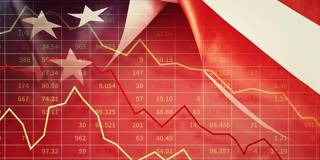Despite running a current-account deficit for decades, America's investment income has remained positive, meaning that debt-servicing was never a problem for the US government. But, amid geopolitical tensions and monetary tightening, America’s external sustainability is hardly a foregone conclusion.
BEIJING – In 2004, everyone started talking about global imbalances. With America’s current-account deficit at an alarming 5.3% of GDP, it was feared that America’s net foreign-debt-to-GDP ratio would climb to the point that foreign investors would demand a higher risk premium on dollar-denominated assets. The specter of a “sudden stop,” a dollar crash, and an international payment crisis seemed to be stalking the global economy.
None of this has happened. Instead, America’s current-account deficit shrank, averaging 2.7% from 2009 to 2021. More impressive, its investment income remained positive, despite its massive net debt, meaning that debt-servicing was never a problem for the US government. And yet, America’s external sustainability is hardly a foregone conclusion.
America’s current-account deficit has grown significantly since 2020, reaching 3.6% of GDP last year – its highest level since 2008. At the same time, its net foreign debt reached a staggering $18 trillion, or 78% of GDP. And fast-rising inflation has prompted the US Federal Reserve to begin raising interest rates and reducing its holdings of Treasury securities – moves that are likely to impede growth and increase the government’s borrowing costs.

BEIJING – In 2004, everyone started talking about global imbalances. With America’s current-account deficit at an alarming 5.3% of GDP, it was feared that America’s net foreign-debt-to-GDP ratio would climb to the point that foreign investors would demand a higher risk premium on dollar-denominated assets. The specter of a “sudden stop,” a dollar crash, and an international payment crisis seemed to be stalking the global economy.
None of this has happened. Instead, America’s current-account deficit shrank, averaging 2.7% from 2009 to 2021. More impressive, its investment income remained positive, despite its massive net debt, meaning that debt-servicing was never a problem for the US government. And yet, America’s external sustainability is hardly a foregone conclusion.
America’s current-account deficit has grown significantly since 2020, reaching 3.6% of GDP last year – its highest level since 2008. At the same time, its net foreign debt reached a staggering $18 trillion, or 78% of GDP. And fast-rising inflation has prompted the US Federal Reserve to begin raising interest rates and reducing its holdings of Treasury securities – moves that are likely to impede growth and increase the government’s borrowing costs.